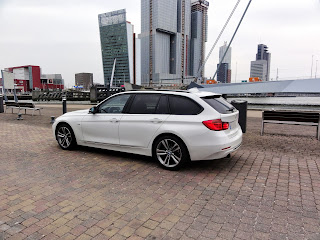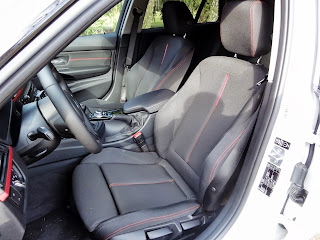In the post few blogs, we have posted a car review on the BMW 335i xDrive and a set of pictures on the BMW 318d Touring, both belonging to the new generation 3-series that is internally know as the "F30 / F31".
Guitigefilmpjes has hit the road with both the 335i xDrive F30 and 318d Touring F31 in order to see how the fuel economy is when driving in real life circumstances and if the engines live up to its expectations. Technical details can be found below:
Model designation: 335i xDrive
Engine: N55B30 6-cylinder TwinPower-Turbo petrol engine (2979 cm³)
Transmission: 8-speed sport automatic transmission
Performance: 306hp (225kW) / 400nm
0 to 100km/h: 5,0sec
Top speed: 250km/h (155mp/h)
Fuel tank (US gallons): 60 liters (15.85 US gallons)
Performance: 306hp (225kW) / 400nm
0 to 100km/h: 5,0sec
Top speed: 250km/h (155mp/h)
Fuel tank (US gallons): 60 liters (15.85 US gallons)
Fuel consumption depends on many different factors, like the tire pressure / size of alloy wheels, the weight of the car (4 people with bagage or travelling alone). The driving profile is the most important determinant of the result. Therefore you can find the driving profile during this trip below:
- 350 kilometers (310 miles) Autobahn at high speeds, 180km/h and more
- 400 kilometers (125 miles) Autobahn between 100km/h and 130km/h
- 170 kilometer secondary road between 80km/h and 100km/h
- 17 kilometer city traffic in normal conditions, outside rush hours
The total trip was 937 kilometers (586 miles), and in contrast to previous tests where I tried to achieve the best possible consumption, this time I had some more fun while accelerating and used the "sport-mode" on a regular basis, leading to a higher consumption. Driving more considerate could probably results in a consumption of 1,5l / 100km to 2,0l / 100km lower then below.
Driving this way has resulted in an average fuel consumption of 11,2l / 100km (21mpg US) as calculated by the car itself, but it is well known that trip computers tend to understate the actual fuel consumption. After having calculated the consumption manually, I found a result of 11,78l / 100km, a difference of 0,58l / 100km or 5,2%.
Model designation: 318d Touring
Engine: 4-cylinder diesel engine (1995 cm³)
Transmission: 6-speed manual transmission
Performance: 143hp / 320nm
0 to 100km/h: 9,2sec
Top speed: 210km/h (131mp/h)
Fuel tank (US gallons): 57 liters (15.1 US gallons)
Performance: 143hp / 320nm
0 to 100km/h: 9,2sec
Top speed: 210km/h (131mp/h)
Fuel tank (US gallons): 57 liters (15.1 US gallons)
In the past, cars with a manual transmission were considered to have superior fuel economy compared to their counterparts with an automatic transmission. Nowadays, it is the other way around, as the manual transmission only has six gears while the automatic transmission has eight.
When driving this BMW 318d Touring, I had the following driving profile. Opposite to the 335i xDrive above, I was driving the 318d in such a way that saves more fuel, though a more stricter driving style could have saved just a bit (o,5l ~ 1,0l / 100km) more fuel.
- 300 kilometers (310 miles) Autobahn at high speeds, 180km/h+
- 900 kilometers (125 miles) Autobahn between 100km/h and 130km/h
- 260 kilometer secondary road between 80km/h and 100km/h
- 27 kilometer city traffic in normal conditions, outside rush hour
Previous fuel consumption reports:
- Audi A4 2.0 TDI / Audi A6 3.0 TDI / Mercedes Benz E220 CDI
- BMW 530d xDrive / Mercedes Benz C220 CDI
- Mercedes Benz C180 / VW Passat 1.4 TSI / BMW 520d Touring
- Audi A6 3.0 TDI 204hp (MY2012 / C7)
- Mercedes Benz C180 Avantgarde BlueEffiency Facelift
- Audi A4 2.0 TDI Avant Facelift
- BMW 520d / 525d xDrive Touring
And watch the designated playlist on Youtube here, that features many more fuel consumption tests on video.














































